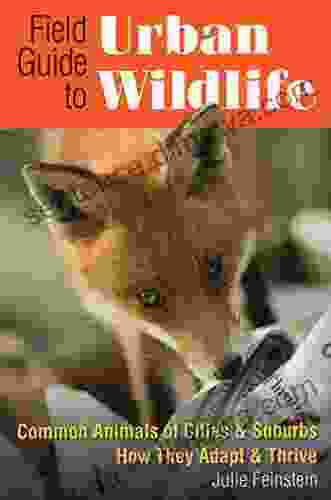Common Animals of Cities and Suburbs: How They Adapt and Thrive

As humans expand their reach into urban and suburban landscapes, they inevitably encounter a diverse array of animal species that have adapted to share this unique environment. From the ubiquitous squirrels scampering across power lines to the elusive coyotes prowling under the cover of night, cities and suburbs offer a fascinating melting pot of wildlife.
Urban Wildlife: A Thriving Paradox
Cities, once thought to be devoid of significant wildlife, have surprisingly become havens for many animal species. The abundance of food, shelter, and water in these sprawling environments, coupled with the absence of natural predators, has attracted countless creatures, both native and non-native, to urban centers.
4.5 out of 5
| Language | : | English |
| File size | : | 38206 KB |
| Text-to-Speech | : | Enabled |
| Screen Reader | : | Supported |
| Enhanced typesetting | : | Enabled |
| Print length | : | 465 pages |
In suburban areas, the merging of natural and built environments creates a unique ecological niche for wildlife. Woodlands and open fields provide ample habitat for species that thrive on the fringes of human development. These transitional zones offer diverse food sources, nesting sites, and cover for a wide range of animals.
Remarkable Adaptations of Urban Animals
To survive and thrive in the urban jungle, animals have evolved remarkable adaptations that allow them to navigate the challenges of city living. Here are some fascinating examples:
- Dietary flexibility: Many urban animals have become adept at exploiting unconventional food sources. Squirrels, for instance, have learned to raid bird feeders and scavenge discarded food scraps, while raccoons have mastered the art of dumpster diving.
- Behavioral plasticity: Urban animals often exhibit behavioral changes in response to human activities. Coyotes, once nocturnal hunters, have become increasingly active during the day in urban environments to avoid encounters with humans. White-tailed deer, once wary of humans, have become accustomed to their presence in parks and suburban neighborhoods.
li>Structural modifications: Some urban animals have even undergone physical changes in response to their environment. House sparrows, for example, have developed smaller wings and shorter tails than their rural counterparts, allowing them to maneuver more easily in urban spaces.
Common Animals of Cities and Suburbs
Let's delve into some of the most common animal species found in cities and suburbs:
- Squirrels: These ubiquitous rodents are highly adaptable and thrive in urban environments. Eastern gray squirrels, red squirrels, and fox squirrels are commonly spotted scampering among trees and raiding bird feeders.
- Raccoons: Known for their dexterity and intelligence, raccoons are nocturnal omnivores that inhabit both urban and suburban areas. They are often drawn to garbage cans, compost piles, and pet food bowls.
- Coyotes: These elusive predators have become increasingly common in urban environments, where they prey on rodents, rabbits, and even small pets. They are typically shy and avoid direct contact with humans.
- White-tailed deer: Once associated with rural areas, white-tailed deer have adapted to suburban landscapes. They feed on vegetation in parks, yards, and along roadsides, sometimes causing conflicts with humans.
- Birds: Cities and suburbs are home to a variety of bird species, including pigeons, sparrows, robins, and blue jays. These feathered creatures find food and nesting sites in urban structures and green spaces.
Ecological Importance of Urban Wildlife
While urban wildlife can sometimes be perceived as a nuisance or a threat, it plays a vital role in urban ecosystems. These animals contribute to seed dispersal, pollination, and nutrient cycling. They also provide a natural check on rodent populations and serve as prey for larger predators.
Moreover, urban wildlife offers opportunities for human connection with nature. Observing and appreciating wildlife in our cities and suburbs can foster a sense of wonder, promote environmental awareness, and enrich our overall well-being.
Living Harmoniously with Urban Wildlife
Coexisting with urban wildlife requires a balanced approach that respects both the needs of wildlife and the safety of humans. Here are some tips for fostering a harmonious relationship with our urban neighbors:
- Secure food sources: Keep pet food indoors and secure garbage cans to prevent attracting animals.
- Protect nesting sites: Avoid disturbing bird nests or blocking access to wildlife dens.
- Respect wildlife boundaries: Observe animals from a distance and do not approach or feed them.
- Minimize conflicts: Use motion-activated lights, fencing, or noise deterrents to discourage animals from entering unwanted areas.
By following these guidelines, we can create a more harmonious urban environment where humans and wildlife coexist peacefully.
The world of urban wildlife is a fascinating and ever-changing tapestry of adaptation, resilience, and ecological interconnectedness. By understanding and appreciating the common animals that share our cities and suburbs, we can foster a more harmonious and sustainable relationship with our wild neighbors.
Whether you're a seasoned urban explorer or simply curious about the hidden wildlife in your own backyard, this comprehensive guide will provide you with insights and practical tips to enhance your connection with the creatures that call our urban and suburban environments home.
4.5 out of 5
| Language | : | English |
| File size | : | 38206 KB |
| Text-to-Speech | : | Enabled |
| Screen Reader | : | Supported |
| Enhanced typesetting | : | Enabled |
| Print length | : | 465 pages |
Do you want to contribute by writing guest posts on this blog?
Please contact us and send us a resume of previous articles that you have written.
 Book
Book Novel
Novel Page
Page Chapter
Chapter Text
Text Story
Story Genre
Genre Reader
Reader Library
Library Paperback
Paperback E-book
E-book Magazine
Magazine Newspaper
Newspaper Paragraph
Paragraph Sentence
Sentence Bookmark
Bookmark Shelf
Shelf Glossary
Glossary Bibliography
Bibliography Foreword
Foreword Preface
Preface Synopsis
Synopsis Annotation
Annotation Footnote
Footnote Manuscript
Manuscript Scroll
Scroll Codex
Codex Tome
Tome Bestseller
Bestseller Classics
Classics Library card
Library card Narrative
Narrative Biography
Biography Autobiography
Autobiography Memoir
Memoir Reference
Reference Encyclopedia
Encyclopedia Hillary Kerr
Hillary Kerr Iain Gale
Iain Gale Ted Hutchin
Ted Hutchin Jahan Brian Ihsan
Jahan Brian Ihsan Ken Zimmerman Jr
Ken Zimmerman Jr Jesse Wiley
Jesse Wiley William P Cassidy
William P Cassidy Michael Anthony Steele
Michael Anthony Steele Theodoros And Ioannis Vasilopoulos
Theodoros And Ioannis Vasilopoulos Julia Mcguire
Julia Mcguire I P Castro
I P Castro J Edward Lee
J Edward Lee Igor V Alabugin
Igor V Alabugin Yuiko
Yuiko Ivan Doig
Ivan Doig Iara Dias Dos Santos
Iara Dias Dos Santos Sara Ella
Sara Ella Shaan Patel
Shaan Patel Sharan Kumar Ravindran
Sharan Kumar Ravindran Reds Johnson
Reds Johnson
Light bulbAdvertise smarter! Our strategic ad space ensures maximum exposure. Reserve your spot today!
 Derrick HughesFollow ·12.9k
Derrick HughesFollow ·12.9k F. Scott FitzgeraldFollow ·6.7k
F. Scott FitzgeraldFollow ·6.7k Virginia WoolfFollow ·7.1k
Virginia WoolfFollow ·7.1k Clarence BrooksFollow ·6.9k
Clarence BrooksFollow ·6.9k DeShawn PowellFollow ·15k
DeShawn PowellFollow ·15k Truman CapoteFollow ·10.4k
Truman CapoteFollow ·10.4k Gerald ParkerFollow ·5.5k
Gerald ParkerFollow ·5.5k David BaldacciFollow ·3k
David BaldacciFollow ·3k

 Ike Bell
Ike BellShakespeare and the Imprints of Performance: A Journey...
Unveiling the Dynamic Legacy of...

 Wade Cox
Wade CoxEducational Entrepreneurship Today: The Key to...
What is Educational Entrepreneurship? ...

 Jason Reed
Jason ReedLearn the Parts of the Violin: A Comprehensive Guide for...
The violin is a beautiful and...

 Will Ward
Will WardJudge Landis and 25 Years of Baseball: An Unparalleled...
Buckle up for an extraordinary journey through...
4.5 out of 5
| Language | : | English |
| File size | : | 38206 KB |
| Text-to-Speech | : | Enabled |
| Screen Reader | : | Supported |
| Enhanced typesetting | : | Enabled |
| Print length | : | 465 pages |
















